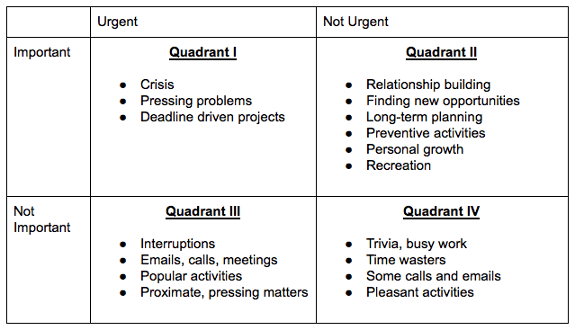Among all the valuable assets you own, time is the most precious of all. In today's fast-paced world, lack of time management is the most significant problem that people have. With so much time spent working, there is no time for personal pursuits.
It is common to feel overwhelmed with responsibilities and activities. The more you work, the further behind you feel. Instead of deciding what you want to do, you react to what's happening around you.
The article explains how you can use Covey's Four Quadrants strategy to focus on the most important tasks and be more productive.
Covey’s 4 Quadrants

The 4 Quadrants Time Management Strategy was created by Steven Covey. He is the author of the famous book The Seven Habits of Highly Effective People. Covey's matrix helps to prioritize tasks based on the time available for optimal efficiency.
The basic idea behind this strategy is to divide your activities into four quadrants depending on their importance and urgency. Let's discuss both of these terms before moving on to the strategy itself.
1. Important: These are the tasks or goals most likely to impact your long-term success.
2. Urgent: Urgent tasks are those that require immediate action. You can't delay them.
Four Quadrants of Time Management Matrix
These are the four quadrants of the Time Management Matrix:
1. Q1: Urgent and important.
2. Q2: Not Urgent but important.
3. Q3: Urgent but not important.
4. Q4: Not urgent and not important.
By prioritizing your tasks across four quadrants, you can differentiate between tasks that make a real difference in the end. The following is a brief overview of what each quadrant contains.
Q1: Urgent and Important:
In Covey's time management matrix, this quadrant is located at the top left. Problems and crises that require immediate attention belong in quadrant one. Neglecting them, in the long run, can be problematic for you.
Preparing a presentation for an important meeting that will commence after a short time is a type of task that falls in quadrant one. It's urgent because you don't have much time for it and it's important as you have to get it ready before the meeting starts.
Tasks involving deadlines, school assignments, sending daily emails, and similar activities with direct impact are urgent and important.
Q2: Not Urgent but Important:
In Covey's time management matrix, this quadrant is on the top right. In this quadrant, you will find tasks that directly relate to your long-term goals. It requires your thorough attention; however, it is not urgent as there is no limited time to complete this task.
If you have a long-term goal of establishing your reputation in an office or class, it may not be that urgent; however, it is still important. Developing relationships, long-term planning, personal development, improving health, and related activities fall within this quadrant.
Q3: Urgent but Not Important:
This quadrant is located in the bottom left corner of Covey's time management matrix. All those activities may seem urgent to you, but you can remove them from the workflow since they hold minimal importance for you.
Let's say you are working on an important project and you get a call from a colleague asking you to join a meeting. If the meeting is unplanned without an agenda, you may choose to skip it. Since, overall, it won't have any positive impact on your life.
In other words, all the time-wasting activities fall in this quadrant. No matter if it's unimportant calls or sending emails that don't add any value.
Q4: Not Urgent and Not Important:
In Covey's time management matrix, this quadrant is at the bottom right-hand side. All activities that take up time without producing any value fall into this quadrant. You can save valuable time by avoiding those chores and spending it on more valuable activities.
The tasks you do for entertainment alone, such as watching the television, surfing the web for hours, gossiping about people, are neither urgent nor important for you.
Benefits of Following Covey’s Time Management Matrix:

1. Productivity Boost: Following the time management matrix changes how you deal with the tasks, helping you prioritize them better. If you shrink the amount of time you spend on tasks, then you can significantly increase your productivity.
2. Work-Life Balance: By planning well, you can get rid of your hectic routine effectively. This way, you can spend more time with your friends and family.
3. Chasing Goals: By diverting your attention to important tasks, you can speed up the process of chasing the goals.
4. Avoids Embarrassment: By recognizing the urgent tasks, you can differentiate them from less urgent ones to better meet the deadlines. This way, you can avoid embarrassment and save your reputation.
Importance of Placing Tasks in Right Quadrant:

Even once you understand this strategy, it remains imperative to assign tasks to the correct quadrants. It would be best if you determined the importance and urgency of the task before fitting it into any quadrant. Make sure you spend a good time arranging your tasks in different quadrants to facilitate their smooth execution.
A good understanding of the time management matrix is a prerequisite to implementing it properly. Put this strategy to work on your everyday task to see if it makes any difference. By managing time and putting yourself in the right spot, you can significantly boost your productivity.
Be More Organized With Covey’s Time Management Strategy
Covey's four-quadrant matrix is one of the most important and famous models in the world of time management. Following this strategy correctly will help you be more productive and stay more active.
Perfect organization and properly prioritizing tasks enable you to accomplish more in less time. You can also determine which tasks require more attention and allocate them accordingly.
However, you can reassign time from lower-value activities to higher-value ones even when that time is irreplaceable. If you are still struggling to organize your day, you can search for other time management strategies like the 80/20 rule to make yourself a more organized person.